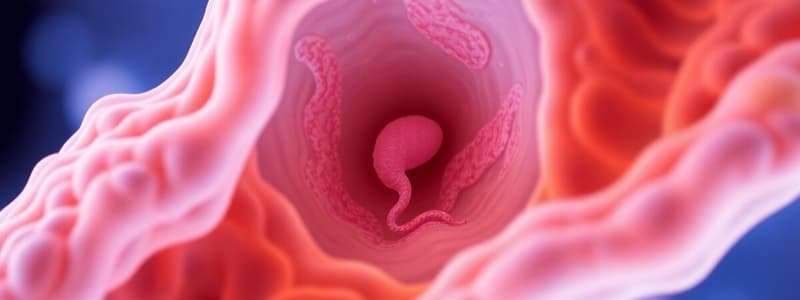Podcast
Questions and Answers
All living things are made up of cells.
All living things are made up of cells.
True (A)
Which of the following organisms can be unicellular?
Which of the following organisms can be unicellular?
- Animals
- Bacteria (correct)
- Fungi
- Plants
What is required for the survival of species?
What is required for the survival of species?
Reproduction
What do all living things do as part of growth and development?
What do all living things do as part of growth and development?
All organisms start as a _____ cell.
All organisms start as a _____ cell.
What are the seven characteristics of life?
What are the seven characteristics of life?
Viruses are considered living organisms.
Viruses are considered living organisms.
What is metabolism?
What is metabolism?
Homeostasis is the process by which organisms maintain a stable _____ environment.
Homeostasis is the process by which organisms maintain a stable _____ environment.
What is biology?
What is biology?
Which of these is an example of a biotic factor?
Which of these is an example of a biotic factor?
All living things can pass on traits to their offspring.
All living things can pass on traits to their offspring.
What is an example of a behavioral adaptation?
What is an example of a behavioral adaptation?
Which type of adaptation helps animals see in different light conditions?
Which type of adaptation helps animals see in different light conditions?
Flashcards are hidden until you start studying
Study Notes
Cellular Organization
- All living things are made up of cells.
- Cells are the smallest unit capable of all life functions.
- Cells can function alone or in groups, forming tissues and organs.
- Organisms can be single-celled (unicellular) or multicellular.
Reproduction
- All living things reproduce to produce more of their own kind.
- Reproduction is necessary for the survival of the species.
Growth and Development
- All living things increase in size.
- All living things change and mature over time.
- Multicellular organisms start as a single cell that divides into many specialized cells.
- Cells differentiate to perform specific functions.
- Plant cells differentiate to perform functions like water absorption, transport, and light absorption.
- Animal cells differentiate from stem cells into various cell types.
Metabolism/Requires Energy
- All living things perform chemical reactions to obtain and use energy.
- Metabolism is the sum of all chemical reactions in an organism.
- Organisms need chemical reactions to make molecules and structures, and to break down molecules for energy.
Homeostasis
- All living things maintain a stable internal environment, called homeostasis.
- Organisms respond to internal and external environment changes to maintain stability.
- Stable body conditions are essential for survival.
- Organisms attempt to restore stability when disrupted.
- Examples of homeostasis include: blood glucose regulation, waste removal, body temperature regulation.
Heredity
- All living things pass on traits to their offspring through genes.
- Genes are contained in DNA, the molecule of heredity.
Responsiveness
- All living things respond to stimuli.
- Stimuli cause a reaction in organisms.
- Examples of responsiveness include:
- Phototropism (plants growing towards light),
- Phototaxis (organisms moving towards or away from light),
- Thigmotaxis (organisms responding to touch),
- Reflexes (automatic responses to protect organisms from harm).
Growth and Development
- All living things grow and develop.
- Growth involves an increase in size, while development involves changes and maturation over time.
Adaptations
- Adaptations are inherited changes that occur over time.
- Adaptations are changes that make species better able to survive and reproduce.
- They help species pass on genes to offspring.
Example: Eye Adaptation
- Eye adaptation allows eyes to adjust to different light conditions.
- Round pupils are common in predators hunting during the day.
- Vertical slit pupils are found in ambush predators, allowing for greater light intake.
- Horizontal pupils in prey animals provide a wide field of view for spotting predators.
- Horizontal slit pupils are found in prey animals like frogs, toads, snakes, and octopuses.
Behavioral Adaptations
- Behavioral adaptations are how animals act.
- There are two types of behavioral adaptations: inherited and learned.
Inherited Behaviors:
- Migration
- Hibernation
- Nocturnal behavior
- Defensive behaviors
- Mating or courtship behaviors
Learned Behaviors:
- Finding food
- Shelter building
- Communication
- Group interaction
- Predator avoidance
Physical Adaptations
- Physical adaptations are structural changes in body parts.
- Examples include:
- Types of feet
- Kinds of claws
- Types of mouths and beaks
- Kinds of body coverings
Color and Pattern
- Color and pattern can serve as adaptations:
- Camouflage (blending into the environment)
- Mimicry (resembling something else)
What is Biology?
- Biology is the study of life.
- Bio - life
- Logos – study of
Living vs Nonliving
- Biotic Factors:
- Bacteria
- Fungi
- Plants
- Protists (algae, amoebas)
- Animals
- Abiotic Factors:
- Water
- Soil
- Viruses
- Sun
- Rocks
- Clouds
Viruses
- Viruses are not considered living organisms.
- They cannot reproduce on their own.
- They are not made up of cells.
- They cannot grow and metabolize.
- They need to take over a host cell to reproduce.
- The infected cell is called the host cell.
Studying That Suits You
Use AI to generate personalized quizzes and flashcards to suit your learning preferences.




